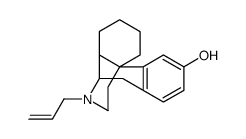levallorphan hydrogen tartrate

levallorphan hydrogen tartrate structure
|
Common Name | levallorphan hydrogen tartrate | ||
|---|---|---|---|---|
| CAS Number | 71-82-9 | Molecular Weight | 283.40800 | |
| Density | N/A | Boiling Point | 660.4ºC at 760 mmHg | |
| Molecular Formula | C19H25NO | Melting Point | N/A | |
| MSDS | Chinese USA | Flash Point | 353.2ºC | |
| Symbol |

GHS07 |
Signal Word | Warning | |
|
The mu opioid irreversible antagonist beta-funaltrexamine differentiates the discriminative stimulus effects of opioids with high and low efficacy at the mu opioid receptor.
Psychopharmacology 140 , 20, (1998) The purpose of the present study was to determine the relative intrinsic efficacy of various opioids using the irreversible mu opioid antagonist beta-funaltrexamine (betaFNA). To this end, pigeons were trained to discriminate 3.0 (n=6) or 1.8 (n=1) mg/kg morp... |
|
|
mu-Opioid receptor-stimulated guanosine-5'-O-(gamma-thio)-triphosphate binding in rat thalamus and cultured cell lines: signal transduction mechanisms underlying agonist efficacy.
Mol. Pharmacol. 51 , 87-96, (1997) G protein activation by different mu-selective opioid agonists was examined in rat thalamus, SK-N-SH cells, and mu-opioid receptor-transfected mMOR-CHO cells using agonist-stimulated guanosine-5'-O-(gamma-thio)-triphosphate ([35S]GTP gamma S) binding to membr... |
|
|
Delta opioid modulation of the binding of guanosine-5'-O-(3-[35S]thio)triphosphate to NG108-15 cell membranes: characterization of agonist and inverse agonist effects.
J. Pharmacol. Exp. Ther. 283 , 1276, (1997) The ability of the delta opioid agonist DPDPE ([D-Pen2, D-Pen4]enkephalin) to stimulate binding of the GTP analog guanosine-5'-O-(3-[35S]thio)triphosphate ([35S]GTPgammaS) to pertussis toxin-sensitive G proteins has been characterized in membranes from NG108-... |
|
|
Regulation of epithelial cell morphology and functions approaching to more in vivo-like by modifying polyethylene glycol on polysulfone membranes.
PLoS ONE 7(4) , e36110, (2012) Cytocompatibility is critically important in design of biomaterials for application in tissue engineering. However, the currently well-accepted "cytocompatible" biomaterials are those which promote cells to sustain good attachment/spreading. The cells on such... |
|
|
A one-step electrospray-based technique for modulating morphology and surface properties of poly(lactide-co-glycolide) microparticles using Pluronics®.
Int. J. Nanomedicine 7 , 5129-36, (2012) The influence of morphology and surface properties on the therapeutic efficacy of degradable polymeric microparticles has not been well understood. One of the primary reasons for this is the limited ability to fabricate microparticles with controlled morpholo... |
|
|
Development and characterization of self-assembling lecithin-based mixed polymeric micelles containing quercetin in cancer treatment and an in vivo pharmacokinetic study.
Int. J. Nanomedicine 11 , 1557-66, (2016) Quercetin (Que) is known to have biological benefits including an anticancer effect, but low water solubility limits its clinical application. The aim of this study was to develop a lecithin-based mixed polymeric micelle (LMPM) delivery system to improve the ... |
|
|
Physical characterization and in vivo pharmacokinetic study of self-assembling amphotericin B-loaded lecithin-based mixed polymeric micelles.
Int. J. Nanomedicine 10 , 7265-74, (2015) To alleviate the inherent problems of amphotericin B (AmB), such as poor water solubility and nephrotoxicity, a novel self-assembling mixed polymeric micelle delivery system based on lecithin and combined with amphiphilic polymers, Pluronic(®), Kolliphor(®), ... |
|
|
Monitoring of the Zeta Potential of Human Cells upon Reduction in Their Viability and Interaction with Polymers.
Acta Naturae 4 , 78-81, (2012) The dynamic light scattering (DLS) technique was applied in order to assess the zeta potential of the plasma membrane of human cells. At pH 7.4, the cell zeta potential for different types of cells showed variations over a wide range and was equal to -19.4 ± ... |